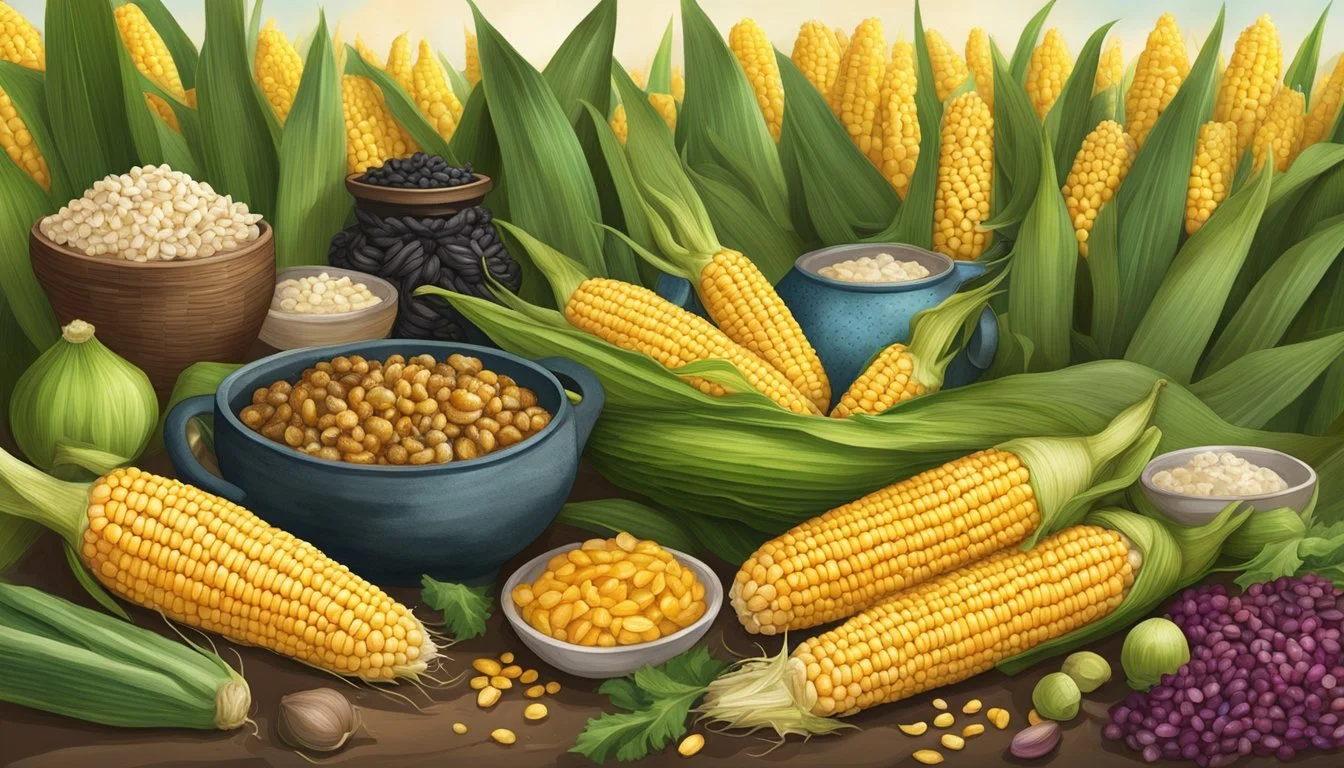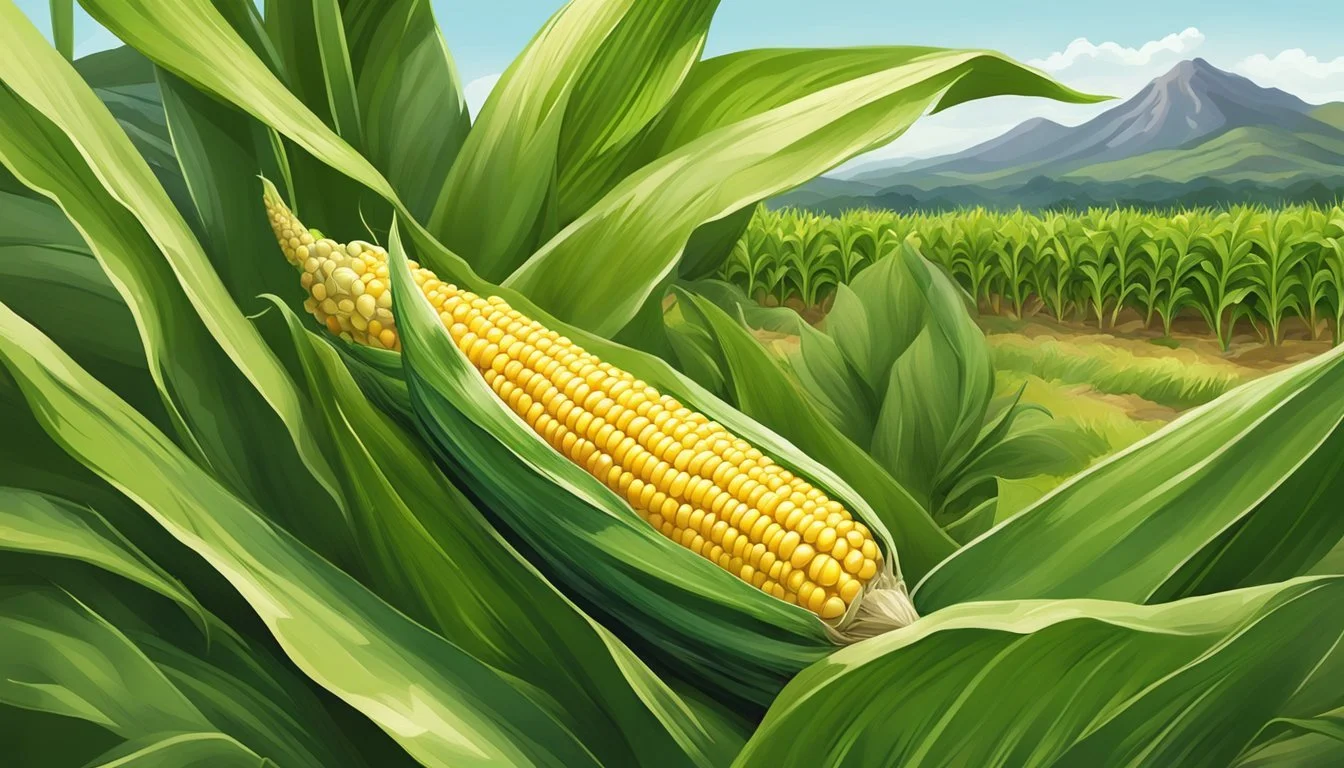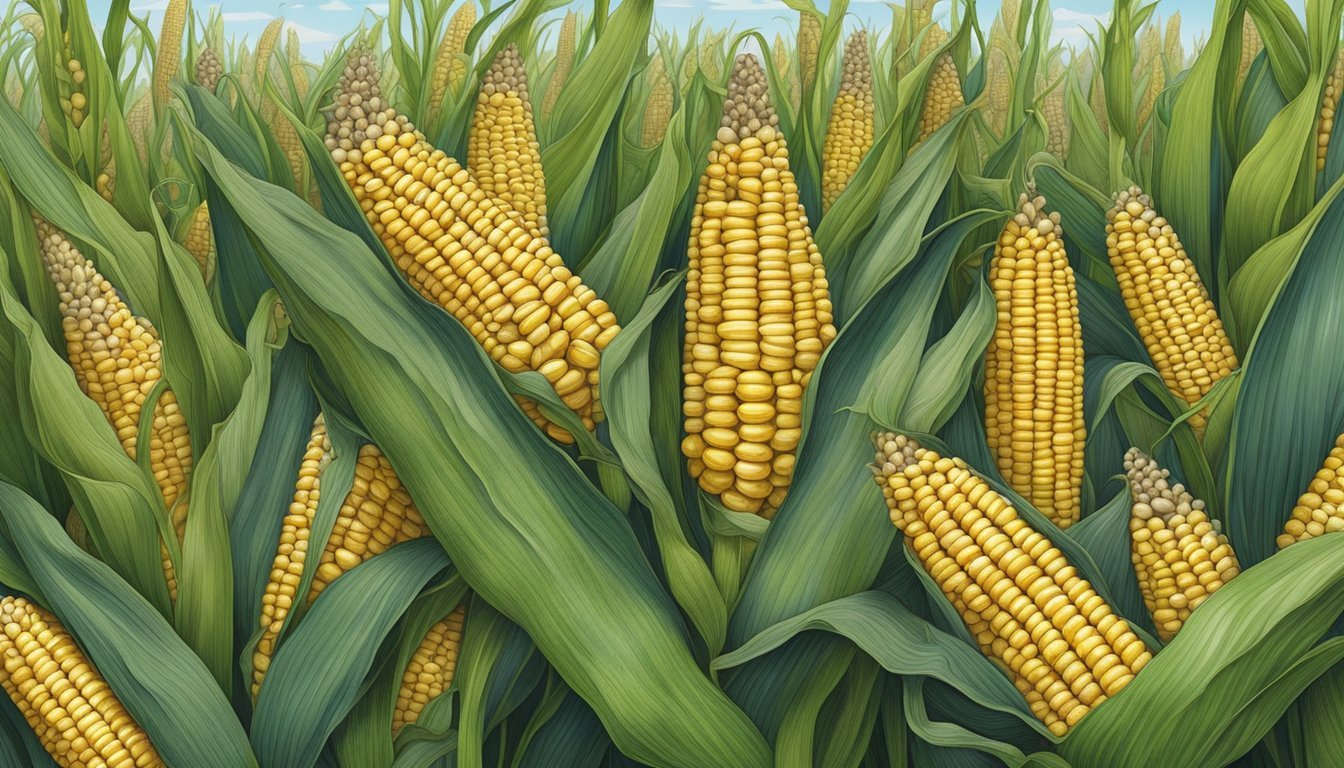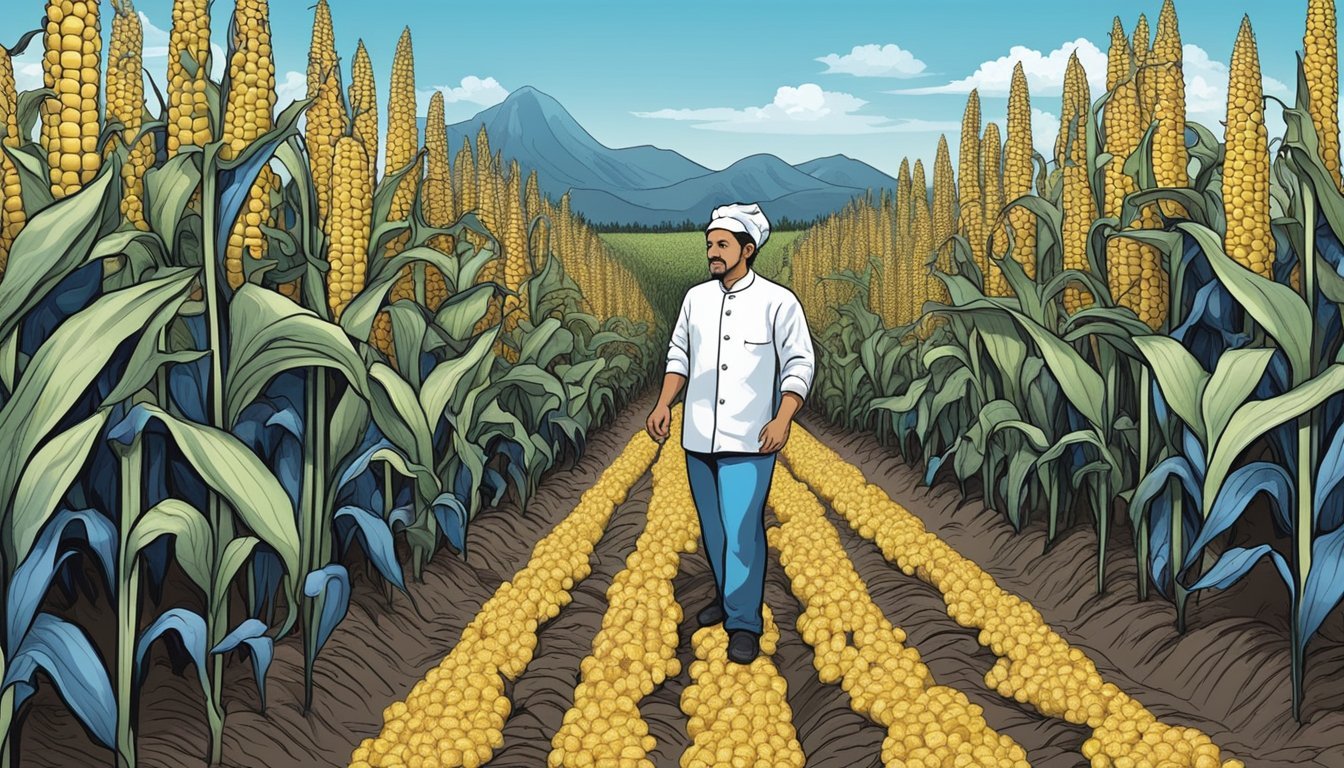Huitlacoche
Unveiling Mexico's Treasured Delicacy
Huitlacoche, also known as corn smut or Mexican truffle, is a culinary delicacy treasured in Mexico and increasingly appreciated around the globe. This distinctive fungus, scientifically named Ustilago maydis, transforms ordinary corn kernels into swollen, blue-black galls. These entities contain a rich, mushroom-like ingredient highly valued by chefs and gourmets for its earthy and savory flavors. Far from being an unwanted pest, huitlacoche is celebrated for its unique taste and versatility in the kitchen, where it features in an array of Mexican culinary masterpieces.
In Mexico, the reverence for huitlacoche is deeply rooted in the nation's gastronomic heritage, a tradition dating back to the Aztecs. The art of cultivating and harvesting the fungus is a nod to their sophisticated agricultural practices. As it makes its way into restaurants across the United States, this "Mexican Corn Fungus" is often regarded as a 'Culinary Gold Mine' due to its rarity and complex flavor profile, elevating simple dishes to gourmet status. Yet, despite its burgeoning popularity, huitlacoche remains relatively scarce outside of its native land due to the seasonality, challenges in cultivation, and obstacles in importation, affirming its status as a precious commodity in the culinary world.
The market for huitlacoche in the United States suggests exclusivity, with prices reflecting its rarity and demand. Most often found in the form of frozen goods, it is a product that commands a significantly higher price per pound compared to its host, fresh corn. American diners and chefs alike are gradually uncovering the potential of this fungus, learning to appreciate its unique qualities and integrate it into a broader spectrum of cuisines. As appreciation outside of Mexico grows, huitlacoche is carving out a niche for itself as a treasured ingredient, intrinsic to the innovation and elevation of contemporary culinary experiences.
What Is Huitlacoche?
Huitlacoche, a parasitic fungus thriving on corn, is revered in Mexican cuisine, turning infected corn into a sought-after delicacy. Its complex flavor profile makes it a versatile ingredient in many dishes.
The Fungus Among Us
Ustilago maydis, commonly known as huitlacoche or corn smut, grows on maize plants. The fungus infects the corn kernels, causing them to swell into bulbous, blue-black growths. These galls contain the spores of the fungus and are considered a delicacy in Mexico. Unlike typical plant diseases, huitlacoche is prized for its culinary value.
A Brief History
Huitlacoche has been consumed since the Aztec civilization, reflecting its deep roots in Mexican culture. The Aztecs, among other Mesoamerican civilizations, integrated this fungus into their diet, valuing its taste and nutritional benefits. This historical ingredient has withstood the test of time and remains an integral part of Mexican gastronomy.
Culinary Applications
Chefs treasure huitlacoche, often referred to as Mexican truffle, for its umami-rich, earthy flavor with hints of mushroom. This fungus enhances soups, quesadillas, tamales, and more with its distinctive taste. Its adaptability allows it to be incorporated into a myriad of recipes, asserting its status as a culinary gold mine within Mexican cuisine.
Nutritional Value and Benefits
Huitlacoche is not only a unique culinary ingredient but also a nutritious one. It offers essential nutrients that are beneficial for a balanced diet.
Protein and Amino Acids
Huitlacoche is a good source of protein, which is vital for muscle repair and growth. The fungus contains amino acids, including lysine, which is often lacking in the typical corn diet. Lysine plays a critical role in the body’s maintenance including supporting immune function and tissue health.
Vitamins and Fiber
The corn fungus is rich in vitamins, specifically B-vitamins, which are important for maintaining good health and energy levels. Fiber is another key component of huitlacoche, aiding in digestion and providing a sense of satiety. The presence of both soluble and insoluble fiber helps in the regulation of blood sugar and cholesterol levels.
Culinary Journey: From Field to Table
The culinary journey of huitlacoche begins with meticulous harvesting practices and spans to its accessibility in markets, revealing a transformation from farm blight to gourmet delight.
Harvesting Practices
Farmers in Mexico keenly monitor their cornfields for the appearance of huitlacoche, a fungus that thrives on organic corn during rainy seasons. When the right conditions cause the corn smut to form, it is considered a stroke of luck rather than a plight. Harvesting involves carefully selecting the ears of corn that exhibit the characteristically swollen, blue-black kernels. It is a delicate process that ensures the galls are intact and at the peak stage for culinary use. Unlike other crops, there's no mechanized process for this; it requires the attentive eye and hand of the farmer.
Market Availability
Once harvested, huitlacoche makes its journey to the market. Fresh huitlacoche is highly sought after and typically found in local farmers' markets or specialty grocery stores that cater to authentic Mexican ingredients. Wholesalers may distribute larger quantities to restaurants eager to incorporate this delicacy into their menus. For wider distribution, it can be sold frozen, a preservation method that retains more of its flavor and texture compared to canning. However, canned huitlacoche is also available and provides a convenient option for those without access to fresh or frozen varieties. The journey from field to table showcases the care and cultural significance of this unique ingredient, making it a precious find for both chefs and culinary enthusiasts alike.
Huitlacoche in Mexican Cuisine
Huitlacoche is an esteemed ingredient in Mexican cuisine, turning a corn affliction into savory, earthy-flavored delicacies in countless traditional and innovative dishes.
Traditional Dishes
In traditional Mexican cuisine, huitlacoche, also known as corn smut or Mexican truffle, is treasured for its unique flavor and is incorporated into a variety of dishes. One of the classic preparations is the huitlacoche quesadilla. It is typically sautéed with onions and epazote, an aromatic herb, then enveloped in blue corn tortillas with melted cheese, creating a dish that's as visually arresting as it is delicious.
Another common use of huitlacoche is in tamales, where the fungal delicacy is combined with masa (corn dough), and possibly other ingredients like beans, cheese, or chilies, then wrapped in corn husks and steamed to perfection. Additionally, it's also a popular filling for tacos, and a key ingredient in soups, bringing a deep, mushroom-like flavor profile to the table.
Modern Culinary Innovation
Chefs across Mexico and beyond are now embracing huitlacoche for modern culinary creations, meshing traditional flavors with contemporary techniques. In upscale restaurants, huitlacoche may be used as an innovative topping on pizzas, mixed into pasta sauces, or even employed as a filling in gourmet oren tortillas to add a touch of Mexican flair. The versatility of huitlacoche allows it to be paired with ingredients like squash blossoms, tomatoes, and peppers, offering a contemporary twist on Mexican food (What wine goes well with Mexican food?) staples.
The Economic Impact of Huitlacoche
Huitlacoche has established itself as a profitable niche market for farmers, while also presenting business opportunities beyond Mexican borders through international culinary interest.
On the Farmers' Fields
Mexican farmers have turned the growth of huitlacoche into an economically beneficial practice, despite its reputation in some areas as an unwanted blight. In regions such as Mexico City and Oaxaca, the intentional cultivation of this fungus transforms regular corn fields into more lucrative endeavors.
Farmers benefit from:
Higher prices per pound compared to standard corn
Fungus' ability to thrive in rainy seasons, which can otherwise be challenging for crops
The exploitation of huitlacoche, once considered a bane to maize cultivation, has now become a source of "black gold" for local agrarians.
Beyond the Borders
Latin American cuisine has been increasingly embraced globally, and with it, huitlacoche has found its way onto menus outside of Mexico. This demand elevates its status from a regional specialty to an internationally traded commodity.
Key impacts include:
American farmers exploring huitlacoche cultivation as a specialty crop
Restaurants and consumers willing to pay premium prices
Growth in the export market from Mexico to the United States and other countries
Farmers and exporters alike navigate the challenges of seasonality and import restrictions to meet the rising international demand. This economic impact of huitlacoche continues to grow as it gains prominence in global culinary circles.
Overcoming Misconceptions
In discussing Huitlacoche, it becomes imperative to address the prevalent misconceptions. Shifting perspectives can reveal the potential of this misunderstood delicacy.
Cultural Perception
In various cultures, plant diseases like smut or blight cause dismay among farmers, typically warranting the application of fungicides to protect crop yields. Huitlacoche—a type of smut that afflicts corn—carries a stigma, especially in regions unfamiliar with its culinary value. This fungus, despite its inglorious appearance, is esteemed in Mexico and increasingly in culinary circles globally. It is not viewed as a crop failure but rather as a fortuitous byproduct that transforms a common staple into a sought-after ingredient.
The Edible vs. The Unappealing
One faces a conundrum when weighing the edible merits of huitlacoche against the instinctive aversion to its unappealing appearance. Traditional culinary standards often dictate that fungi such as mushrooms are desirable, while smut on corn is a sign of spoilage. However, chefs—recognizing the rich and earthy flavor profile of huitlacoche—have begun to challenge these assumptions. By approaching huitlacoche with an open mind, individuals can unlock a nuanced taste that is both unique and complex, heralding it as Mexico's answer to an exotic delicacy.
Cooking with Huitlacoche
Huitlacoche is prized in culinary circles for its earthy, mushroom-like flavor that adds depth to various dishes. Its versatility is showcased when incorporated into both traditional and modern recipes.
Preparation Techniques
Huitlacoche may be used raw or cooked, each technique bringing out different qualities of the fungus. When sautéed, it releases a robust aroma and intensifies its rich flavor profile. For convenience, flash frozen huitlacoche is available and retains much of the fresh fungus’s characteristics. To prepare, one should gently heat the huitlacoche in a bit of oil, which helps to amplify its natural flavors before combining it with other ingredients.
Recipe Ideas
Vegetarian Tacos: Sauté huitlacoche with Oaxaca cheese and fold into soft tortillas for a vegetarian twist on a Mexican classic.
Omelets: Incorporate it into omelets for a breakfast with a unique taste, complementing the eggs with its earthy notes.
With Chorizo: Mix it with spicy chorizo for a filling with a perfect balance of earthy and smoky flavors.
In Sauces: Puree huitlacoche for use in complex, nuanced sauces that pair well with meat or vegetables.
Stews: Add it to stews to impart a deep, savory taste that enhances the overall dish.
The Future of Huitlacoche
As huitlacoche gains traction in the culinary world, its future lies in inventive cooking techniques and strengthened partnerships between culinary experts and corn producers.
Culinary Research and Development
Chefs are continually exploring new ways to incorporate huitlacoche into a variety of dishes, beyond traditional Mexican cuisine. Innovation is at the forefront, with emphasis on:
Flavor experimentation: Integrating huitlacoche into non-traditional recipes to create unique taste profiles.
Texture exploration: Capitalizing on its velvety texture to enhance both staple and avant-garde dishes.
Sustainable practices: Using huitlacoche as a symbol of eco-friendly cooking, highlighting the fungus's natural occurrence during the rainy season.
Through these endeavors, huitlacoche not only enriches culinary offerings but also supports sustainable food practices.
Collaboration between Chefs and Farmers
The burgeoning interest in huitlacoche has sparked collaborations that benefit both chefs and corn producers. These partnerships focus on:
Quality and supply: Ensuring a consistent, high-quality supply of huitlacoche for culinary use.
Knowledge sharing: Farmers leverage chef insights on huitlacoche’s culinary potential to cultivate crops that meet market demands.
Culinary-based farming: Programs where chefs work directly with farmers to breed and grow corn varieties best suited for huitlacoche production.
By prioritizing collaboration between culinary professionals and agriculturists, the corn fungus is set to become a more prominent delicacy in global gastronomy while contributing to the livelihoods of local communities.
Exploring Huitlacoche
Huitlacoche offers a deep dive into Mexico's traditional cuisine, providing travelers and food enthusiasts with authentic ways to discover its use through organized tours and special events.
Cuisine Tours and Cooking Classes
In regions like Oaxaca, known for its rich culinary heritage, cuisine tours often include visits to bustling markets where participants can taste huitlacoche right from the market vendors. These tours provide a sensory exploration of Mexican flavors, often leading to small cooking classes where they can learn to prepare huitlacoche dishes. Street vendors also showcase the versatility of this ingredient, incorporating huitlacoche into foods ranging from quesadillas to sophisticated sauces.
Cooking classes emphasize the hands-on experience of working with huitlacoche, teaching participants how to select and clean the fungus, and the subtle art of pairing its earthy flavor with other regional ingredients, including the smoky notes of mezcal, to create dishes that epitomize the essence of Mexican cuisine.
Festivals and Culinary Events
Mexico's fondness for huitlacoche is on full display at festivals and culinary events where entire celebrations are dedicated to this delicacy. One can find festivals where huitlacoche is the star, being used in innovative ways by chefs and home cooks alike. These events provide an opportunity for locals and tourists to experience the richness of Mexican culture and food traditions.
Culinary events frequently feature huitlacoche in their menus, exploring contemporary twists on traditional dishes. Here, attendees may taste how chefs utilize huitlacoche to complement other local products, including cheeses and meats. Festivals give a platform for dialogue about the cultural significance of such traditional ingredients, reinforcing the fungus's place in Mexican food heritage.
Conservation and Sustainability
In the context of huitlacoche, conservation and sustainability efforts focus on protecting indigenous corn varieties and implementing farming practices that support ecosystem health.
Protecting Indigenous Crops
The conservation of indigenous corn crops is critical, as these are the natural hosts of huitlacoche. These crops have adapted over centuries to local conditions and form an integral part of the biodiversity in Mexico. By preserving these heirloom species, farmers maintain the genetic diversity necessary for the fungus to thrive naturally. This practice helps ensure a future for huitlacoche as a sustainable delicacy.
Sustainable Cultivation Methods
Sustainable cultivation of huitlacoche includes methods that minimize environmental impact and promote ecosystem balance. Farmers may employ:
Crop rotation: To maintain soil health and reduce the need for chemical inputs.
Integrated pest management (IPM): Utilizing biological control methods instead of harmful pesticides.
Reduced tillage: To lower soil erosion and carbon emissions.
Water conservation techniques: Such as drip irrigation, to optimize water usage.
Through these methods, farmers aim to produce huitlacoche without depleting natural resources, thus supporting its longevity as a high-value culinary ingredient.
Huitlacoche in Popular Culture
Huitlacoche has made intriguing forays into popular culture, often embodying a blend of tradition and novelty. It appears in creative works and online platforms, reflecting its cultural significance and rising culinary status.
In Literature and Film
In literature, huitlacoche is found sprinkled across the pages of culinary and cultural texts, often symbolizing Mexican heritage and the rich tapestry of its cuisine. Although not a mainstream element in film, it has cameoed in documentaries and indie movies that celebrate or explore Mexican food traditions where its unique nature and gourmet appeal are showcased.
Social Media Influence
On social media platforms, chefs and food enthusiasts have helped huitlacoche gain traction by showcasing its versatility and unique flavor profile. Posts featuring the fungus in various dishes often garner attention, highlighting:
Its use in traditional and contemporary Mexican cuisine
How-to cooking videos that teach preparation techniques
Influencer collaborations with restaurants, promoting huitlacoche special menus
This online visibility has played a part in huitlacoche's transition from a traditional ingredient to a modern delicacy admired by a global audience.
Conclusion
Huitlacoche, often termed the Mexican truffle, has firmly established itself as a culinary delicacy with origins deeply rooted in Mexico's rich gastronomic culture. This edible fungus thrives on corn, specifically the kernels, during the moisture-laden periods of the rainy season, engendering large, bulbous galls. It is unmistakable with its blue-black hue and cloud-like appearance.
Culinary Application:
Chefs prize huitlacoche for its earthy, savory flavor, incorporating it into a multitude of dishes from soups and tamales to quesadillas.
Market Price:
The market reflects its rarity and demand, with prices considerably outweighing those of regular corn. It commands a price of approximately $15 to $20 per pound in the United States, quite the premium compared to other produce.
Challenges:
Despite its popularity in Mexican cuisine, huitlacoche has faced challenges, like stigma and importation hurdles, that have impeded its widespread acceptance outside of Mexico. Nevertheless, its reputation in international kitchens is growing.
Availability:
Given its dependency on the growing conditions, huitlacoche is seasonal and thus can be elusive, which only adds to its allure.
In the realm of gourmet cooking, huitlacoche stands out not just for its unique culinary characteristics, but also for the cultural and agricultural narratives it carries. Its presence on global menus is a testament to the expanding appreciation for diverse flavors and ingredients, and perhaps hints at an evolving palate more open to the unconventional gifts of nature.





